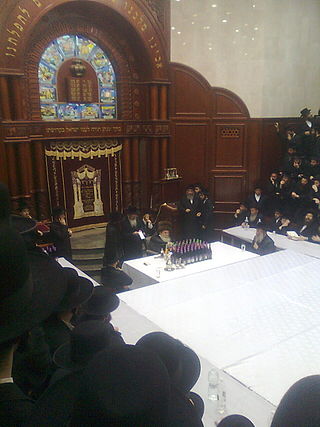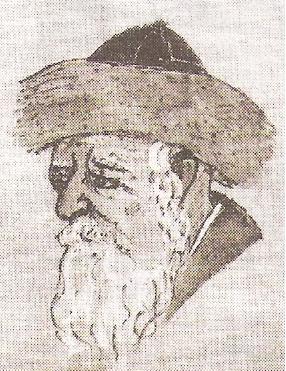
Ger is a Polish Hasidic dynasty originating from the town of Góra Kalwaria, Poland, where it was founded by Yitzchak Meir Alter (1798–1866), known as the "Chiddushei HaRim". Ger is a branch of Peshischa Hasidism, as Yitzchak Meir Alter was a leading disciple of Simcha Bunim of Peshischa (1765–1827). Before the Holocaust, followers of Ger were estimated to number in excess of 100,000, making it the largest and most influential Hasidic group in Poland. Today, the movement is based in Jerusalem, and its membership is estimated at 11,859 families, as of 2016, most of whom live in Israel, making Ger the largest Hasidic dynasty in Israel. However, there are also well-established Ger communities in the United States and in Europe. In 2019, some 300 families of followers led by Shaul Alter, split off from the dynasty led by his cousin Yaakov Aryeh Alter.

Nadvorna is a Hasidic rabbinical dynasty deriving its name from the town of Nadvorna, (Nadvirna), today in Ukraine.

Belz is a Hasidic dynasty founded in the town of Belz in Western Ukraine, near the Polish border, historically the Crown of the Kingdom of Poland. The group was founded in the early 19th century by Rabbi Shalom Rokeach, also known as the Sar Shalom, and led by his son, Rabbi Yehoshua Rokeach, and grandson, Rabbi Yissachar Dov, and great-grandson, Rabbi Aharon, before the Nazi invasion of Poland in 1939. While Aharon managed to escape Europe, together with his brother Rabbi Mordechai Rokeach, most of the Belz Hasidim were murdered in the Holocaust. Aharon re-established the Hasidic community in Israel following World War II. As of the 2020s, Belz has sizable communities in Israel, Western Europe, and the Anglosphere.

Chernobyl is a Hasidic dynasty which was founded by Grand Rabbi Menachem Nachum Twersky, known by his work as the Meor Einayim. The dynasty is named after the northern Ukrainian city of Chernobyl, where Rabbi Nachum was the maggid. The lineage continues to exist, although not always with the name Chernobyl. Several rebbes are named Chernobyl. The central court is in Bnei Brak, headed by Rabbi Menachem Nachum Twersky.

Biala is a Hasidic dynasty originating from the city of Biała Rawska, where it was founded by R. Yaakov Yitzchak Rabinowicz (II). Biala is a branch of Peshischa Hasidism, as R. Yaakov Yitzchak Rabinowicz (II) was the great-grandson of R. Yaakov Yitzchak Rabinowicz, the first Peshischa Rebbe. The dynasty was originally spread throughout many towns in Poland, often taking the names of said towns. However, after the Holocaust, the name "Biala" become synonymous with the entire dynasty. Today the dynasty is mostly concentrated in Israel, America and Switzerland.

Boyan is a Hasidic dynasty named after the town of Boiany in the historic region of Bukovina, now in Ukraine. The Hasidut is headquartered in Jerusalem, with communities in Beitar Ilit, Bnei Brak, Manchester, Australia, Beit Shemesh, London, Antwerp, Manhattan, Brooklyn, Los Angeles, Monsey, Lakewood, and Atlanta. Boyan is one of the branches of the Ruzhiner dynasty, together with Bohush, Chortkov, Husiatyn, Sadigura, Kapishnitz, Vaslui and Shtefanesht.

Slonim is a Hasidic dynasty originating in the town of Slonim, which is now in Belarus. Today, there are two Slonimer factions. Slonim, based in Jerusalem, and the Slonim community in Bnei Brak. They are two distinct groups today, and have many differences between them.

Sadigura is a Hasidic dynasty named for the city of Sadhora, Bukovina, which was part of the Austrian Empire. The dynasty began in 1850 with Rabbi Avrohom Yaakov Friedman, a son of Rabbi Yisrael Friedman of Ruzhyn, and was based in Sadigura until 1914. During the interwar period the dynasty was led by rebbes in Vienna and Przemyśl, Poland, and just before World War II moved to Israel.
The following charts illustrate the family of Rabbi Yisrael Baal Shem Tov, the founder of Hasidic Judaism.
Pinsk-Karlin is a Hasidic group that is an offshoot of Karlin-Stolin.
Aaron Ben Asher of Karlin, known as Rabbi Aaron II of Karlin, was a famous rabbi of the Ḥasidim in northwestern Russia.

Rabbi Yitzchok Friedman was the founder and first Rebbe of the Boyan Hasidic dynasty. He was known as the Pachad Yitzchok.
Aharon ben Jacob Perlov of Karlin, known among the Ḥasidim as Rabbi Aharon the Great, or simply as the "Preacher" or "Censor", was one of the early rabbis of the sect who helped the rapid spread of Ḥasidism in Eastern Europe, and was distinguished for the fiery eloquence of his exhortations. He died one year before his master, Rabbi Dov Ber of Mezeritch, and was succeeded by his disciple, Rabbi Shlomo of Karlin. Rabbi Shlomo was in turn succeeded by Rabbi Aharon's son, Asher.
Koidanov is a Hasidic dynasty originating from the city of Dzyarzhynsk (Koidanov), Belarus, where it was founded by Rabbi Shlomo Chaim Perlow (1797–1862) in 1833. Koidanov is a branch of both Lechovitch Hasidism and Karlin-Stolin Hasidism as Rabbi Shlomo Chaim Perlow was the paternal grandson of Rabbi Mordechai of Lechovitch and the maternal grandson of Rabbi Asher of Stolin. Koidanov was the smallest of the three Lithuanian Hasidic dynasties, with most of its Hasidim being murdered in the Holocaust. The dynasty was re-established after the war in Tel Aviv, then moved to Bnei Brak, where the majority of the dynasty is located, but there are Chassidim located around the world.
Aharon Perlow was the third Rebbe of the Koidanov Hasidic dynasty. He was a charismatic leader who attracted thousands of followers and effected a revival of the Koidanover dynasty founded by his grandfather, Rabbi Shlomo Chaim Perlow (1797-1862). He authored several important works that became standard texts for Koidanover Hasidim to this day, including a siddur, Seder Tefilot Yisrael Or Hayashar.

Avrohom Yaakov Friedman was the first Rebbe of the Sadigura Hasidic dynasty. He lived in the palatial home constructed by his father, Rabbi Yisrael Friedman of Ruzhyn, who fled to the Austrian town of Sadhora due to persecution by the Russian Tsar. He maintained his father's extravagant lifestyle while immersing himself in Torah study and mysticism. He was considered the greatest Rebbe of his era, attracting hundreds of thousands of Jews as well as prominent Christian leaders to his court.
Lechovitch is a Lithuanian Hasidic dynasty, originating from the city of Lyakhavichy, Belarus, where it was founded by Rabbi Mordechai Jaffe. Lechovitch is a branch of Karlin Hasidism as Jaffe was a leading disciple of Rabbi Shlomo of Karlin. The Slonim, Koidanov, and Kobrin dynasties derive from Lechovitch Hasidism.

Hasidic Judaism in Lithuania is the history of Hasidic Judaism and Hasidic philosophy in Lithuania and parts of modern-day Belarus. Hasidic Judaism in Lithuania began with R. Aaron Perlow of Karlin (Karalin) (1736–1772), R. Menachem Mendel of Vitebsk (1730?–1788) R. Shneur Zalman of Liadi (Lyady) (1745–1812) and to a lesser extent R. Hayim Haykl of Amdur (Indura), all of whom were disciples of R. Dov Ber of Mezeritch (Mezhirichi), who in part was the successor to the R. Israel Baal Shem Tov who founded Hasidic Judaism in Western Ukraine. In its earliest years, Lithuanian Hasidism suffered immense persecution by the Lithuanian Misnagdic rabbinate, who attempted to ban and excommunicate Hasidism on several occasions in Lithuania beginning with R. Elijah b. Solomon Zalman of Vilna (1720–1797), who was the earliest disseminator of anti-Hasidic thought which flourished in Lithuania.
Rabbi Shlomo of Karlin was a disciple of the Maggid of Mezeritch and rabbi Aharon the Great of Karlin. After the death of Aharon, Solomon became the leader of the Hasidic dynasty in Karlin. His descendants served as rabbis of Volhynian Hasidism.
Rabbi Asher Perlow of Stolin was the son of Rabbi Aharon the Great of Karlin and the third Admor of the Karlin dynasty, and the founder of its Stolin subdynasty.











